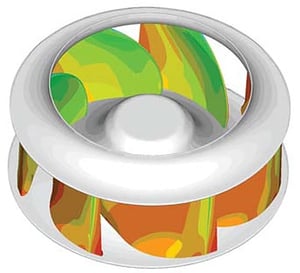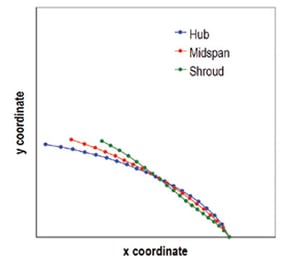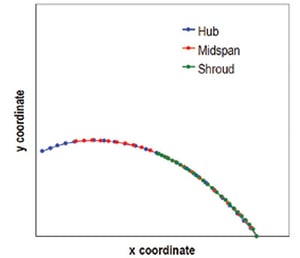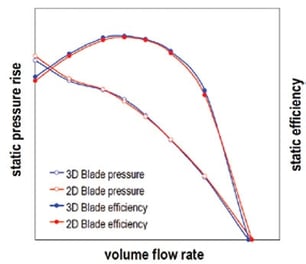Ebm-Papst Mulfingen was founded in 1963 and started with the external-rotor motor which was rediscovered as an ideal drive for small fans. As the pillar and basic principle of the innovative and wide product range, the external-rotor motor made Ebm the world market leader. Today, with approximately 10,000 people in 57 subsidiaries and 17 production facilities worldwide, Ebm-Papst produces high quality fans and motors for many markets such as heating and air-conditioning, ventilation, refrigeration, automotive, IT/telecom and drive technology.
After using TURBOdesign1 for fan blade design for a number of years to reduce development / design time, improve efficiency and reduce noise of their fan blades, Ebm-Papst decided to couple it with an automatic optimization method.

Using an inverse design tool like TURBOdesign1 to design a fan blade for a radial impeller, the resulting blade is a three dimensional one, which means it is curved arbitrarily in radial and axial directions. In order to reduce manufacturing costs, it is crucial in some cases to produce the fans with 2D blades that are curved only in the radial direction. The problem is however, that it has been proven that these 2D blades can often result in an efficiency loss, therefore in order to obtain the best compromise between efficiency and reduced manufacturing costs, both methods are to be used.
To tackle this issue, TURBOdesign1 has a script version that can be easily coupled with any automatic optimizer. The most important design parameters such as blade loading can be controlled by simple text files such as .pcf file. In addition, TURBOdesign1 output files can be used to evaluate both aerodynamic and geometrical parameters directly by the optimizer. As the design process with TURBOdesign1 is very fast, thousands of designs can be carried out overnight, allowing even optimizations with more than 20 input variables. The optimization target is to minimize the deviation of the mid surface from the desired 2D blade subject to constraints on the diffusion ratios below a critical value in order to avoid flow separation.
Although the main design parameters are the blade loading distribution in stream wise direction on different span-wise positions, the meridional channel, thickness distribution and the main specifications such as impeller speed, blade number and volume flow rate remained fixed during the optimization. The process therefore is as follows:
The original design is a 3D blade designed with TURBOdesign1 (Fig. 1), which showed good performance and had excellent efficiency, but was difficult and expensive to manufacture. Then the optimization module is used, so that the geometrically optimized blade (Fig. 2) has almost the same aerodynamic values as the original 3D blade (Fig. 3) and can be manufactured cost-effectively.



“The ability of TURBOdesign1 to optimize the fan performance at a specific duty point was decisive. Optimising the fan impeller design reduced the noise generation by 5 to 6 dB. The new generation of IG Fan has been very well received by our customers”
By Katrin Bohl, Engineer R&D Aerodynamics, Ebm-Papst Mulfingen
The resulting optimized 2D blade addresses the manufacturing constraints and shows the same excellent values for performance and efficiency as the original 3D blade. Manufacturing constraints are only one of numerous possible design targets that can be accomplished by coupling TURBOdesign1 with an automatic optimiser, since this method can be used almost universally.
Book a free personalized demo for your own case with our engineers by completing the form below to start optimizing, reducing cost and development time for your fan design.



Share This Post